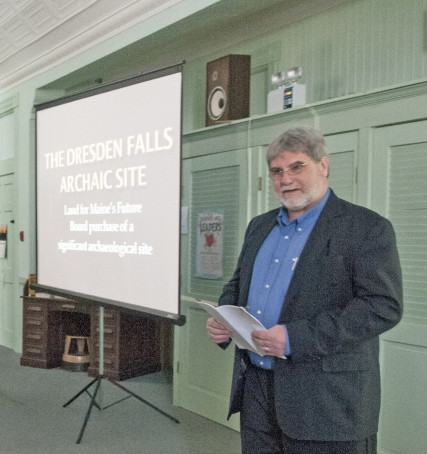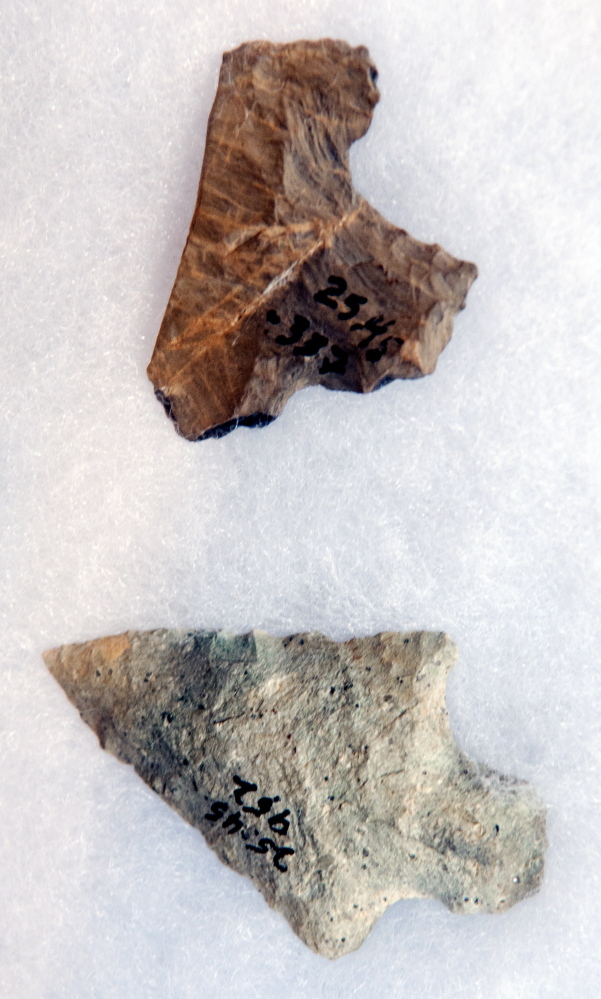DRESDEN — You wouldn’t know it now, but experts say a field here was once a village near a great waterfall.
It was likely one of the best fishing spots in the region, with massive salmon and sturgeon. But about 4,500 years ago, some of Maine’s first indigenous settlers left it.
However, they also left clues about life in Dresden on the Kennebec River as many as 9,000 years ago.
On Sunday, Arthur Spiess, the senior archaeologist for the Maine Historic Preservation Commission, in a lecture at the Bridge Academy Public Library on the Dresden Falls Archaic Site, called for “a major dig” at the site in the future.
The 27-acre parcel on the east side of Swan Island is perhaps Maine’s most important archaeological site. Spiess said there are 6,000 sites in Maine, but only 20 are as old and well-preserved as the Dresden site, the only one of its size in the state.
Dresden’s more recent history is well-documented. In 1765, lawyer John Adams, who later became the second U.S. president, tried a case at Pownalborough Court House. But the indigenous site adds another layer to its story.
“I describe these as the real Mainers,” said Joe Wiley, co-president of the Dresden Historical Society. “They were here before any Europeans were.”
Some of the spearpoints found on the site in recent years date back to as many as 9,000 years ago, when Spiess said the first settlers likely moved into the present-day region as the area warmed after the Ice Age.
Thousands of years ago, Spiess said there was a large waterfall on the river near the site that may have dropped as many as 30 feet and functioned as the Kennebec’s head of tide. Since then, sea levels have risen and submerged it.
Burned bone fragments discovered at the site have shown that fish were plentiful there and made up much of the settlers’ diets along with bass, muskrat, turtles and possibly deer.
“This spot was the greatest spot for fishing for 5,000 years before it got flooded out by the tide,” Spiess said. “That’s our story about this site.”
The state took an interest in the site in 2007, when the new owners of the property wanted to subdivide it. That year, a bill passed the Maine Legislature that allowed the Land for Maine’s Future Program, the state’s primary conservation vehicle, to buy land for archaeological purposes. In 2008, its board put $228,000 toward the site’s purchase.
After years of negotiation, in 2011 with help from Friends of Merrymeeting Bay, the land was bought for approximately $400,000 and is now owned by The Archaeological Conservancy, a national nonprofit. The state must approve digging on the site’s 14-acre historic core.
Since then, only small digs have happened at the site. Many other types of artifacts, including ground slate ulus — primitive all-purpose knives — have also been found there, but there’s nothing in the ground younger than 4,500 years old, which may have been when the falls flooded.
A large dig would require a research team and lots of money, and Spiess said there are no near-term plans for one, but “the site definitely deserves a major dig at some time in the future.”
The recently unearthed history has been new to many, even Eleanor Everson, 86, a lifelong Dresden resident carrying the unofficial title of town historian.
“It makes people realize how old an area (it is) and what it was like way back, prior to settlements in the 1700s,” she said of the site.
Michael Shepherd — 370-7652
Twitter: @mikeshepherdme
Send questions/comments to the editors.




